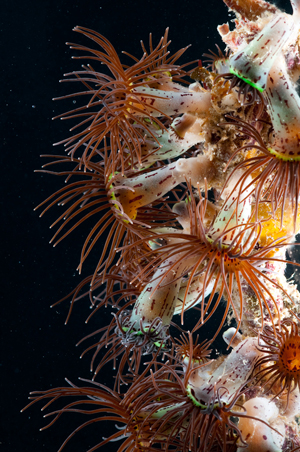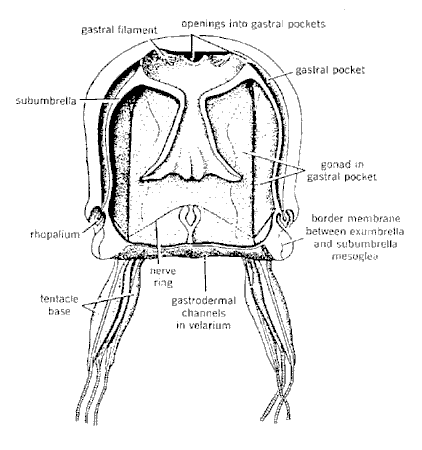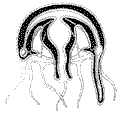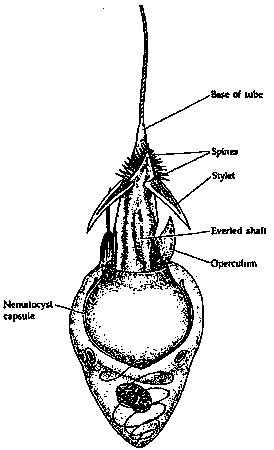
A zoanthid of the genus Acrozoanthus.
Image: Gary Cranitch, © 2008-2010 Australian Institute of Marine Science, Lizard Island 2010, Creative Commons Attribution license
| Cnidaria | ||
| Cnidaria | Cnidaria |
| Metazoa | Metazoa | Metazoa | ||||
| Time |
|
Metazoa
├─Porifera (paraphyletic?)
└─Radiata
├─Ctenophora
└─┬─Anthozoa
│ └─┬─Hydrozoa
│ └─┬─┬─Scyphozoa
│ │ └─Cubozoa
│ └─Conulata
└─Bilateria
├─Deuterostomia
└─Protostomia
├─Ecdysozoa
└─Lophotrochozoa
|
The Cnidaria |
 A zoanthid of the genus Acrozoanthus. Image: Gary Cranitch, © 2008-2010 Australian Institute of Marine Science, Lizard Island 2010, Creative Commons Attribution license |
This diverse group of very simple-bodied animals includes corals, sea anemones, hydras, jellyfishes, and their relatives. About 9,000 living species are known. The Cnidaria are the simplest Metazoa, and do not even possess organs. All they have is a stomach and a mouth surrounded by tentacles.
 Cubozoa |

|
 Hydrozoa |
 Anthozoa |
All cnidarians are radially symmetrical (the body is symmetrical around a central axis). As with the plant, there is no front or rear, but there is a top and bottom.

|

|
|
Polyp |
Medusa |
There are two major body forms among the Cnidaria - the polyp and the medusa. Sea anemones and corals are typical of the polyp form, while jellyfish are typical medusae When you look at it, you can see that these are the same body form, except that one is upside down, while the other is not.
Cnidaria have no organs (i.e. groupings of different tissues to perform complex functions e.g. hearts, lungs, kidneys, etc). There is a gastrovascular cavity ("stomach" in the broad sense) with a mouth but no anus, a body wall with outer epidermis and inner gastrodermis, between which is a jelly-like mesogloea.
The nervous system is arranged as a decentralized network (‘nerve net’), with one or two nets present. There is no brain or ganglia.
Note that although there is no head, there is a mouth, surrounded by a crown of tentacles. The tentacles are armed with deadly nematocysts stinging cells) .
All the metabolic functions of the body - respiration, digestion, elimination - are carried out by diffusion. Diffusion is only an efficient means of exchange of materials only over short distances (e.g. over about 1 mm for oxygen exchange). This means that all the tissues of a cnidarian which require oxygen (all its living cells) must be within about 1 mm of a surface which is bathed by oxygenated water. This is why cnidarians are either very tiny (e.g. coral polyps) or have very thin or flat bodies or long thin tentacles (both of which increase surface area). And also because of this diffusion based physiology, cnidarians can only live in water (most species are marine, but some Hydrozoa live in fresh water). There are only two surfaces in a cnidarian through which this diffusion can occur - the epidermis (the outer layer or skin, which is bathed in water at all times) and the gastrodermis (the inner layer, representing the stomach lining).

Nematocysts are to cnidaria what choanocysts are to sponges. But whereas the gentle filter-feeding sponge simply sweeps microscopic food particles to it, the predatory cnidarian uses batteries of deadly stinging cells that can paralyze and kill quite large prey. These large cells have a sealed central cavity of poisonous fluid. A small sensory hair is sensitive to vibrations in the water. Any luckless creature passing too close triggers the nematocyst which then shoots out the barb, which penetrates the prey so it can be injected with poison. The prey is then conveyed to the mouth by the tentacle.
Despite this primitive grade of organization they are no more ancient than any other group of animal. The Edicarian biota, supposed jellyfish and soft coral (sea pen) fossils from the latest Proterozoic (Ediacaran) era have turned out to belong to a totally different type of organisms, the enigmatic "Vendobionta". although there is still some argument for diploblastic natuer of these organisms. In any case it is inconceivable that large predatory organisms like jellyfish could have existed at a time when there was nothing else around for them to feed on! The first coral organisms only appear in the Middle Cambrian, (or possibly Cambrian Epoch 2), and only diversified during the Ordovician. the first unambiguous jellyfish are also not known before the Cambrian.
There are traditionally four classes of Cnidaria, which represent the three modes of lifestyle:
 Cubozoa (medusa) |

Scythozoa |
 Hydrozoa (polyp and medusa) |
 Anthozoa (polyps) |
It is generally agreed that the Anthozoa are different from the others, but there has been disagreement for over a century on whether they branch first or last. The majority of recent work finds that they branched early, and we follow that trend.
The Tree of Life -- Cnidaria Coelenterata)
University of California Museum of Paleontology -- Cnidaria
The Cnidaria Home Page - links to material on the Cnidaria, arranged accordng to topic
Animal Diversity Web: Phylum Cnidaria - short intro and general information
Cnidaria - a good non-technical intro. Part of Keith Davey's Life on Australian Seashores website
Systema Naturae 2000 / Classification - Phylum Cnidaria
Cnidaria - basic outline